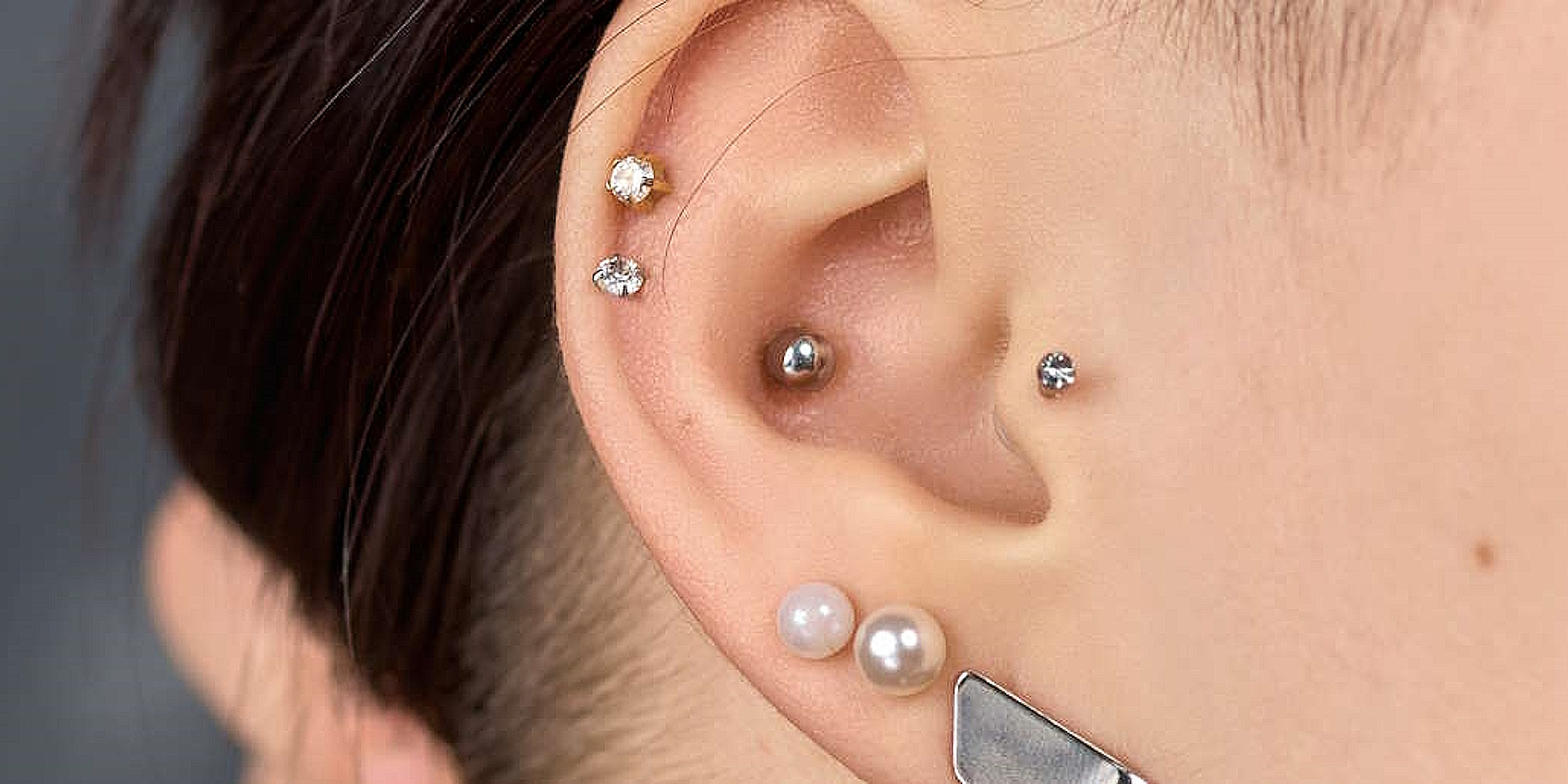Join The Piercing Ya Newsletter
Inner Conch Piercing: A Deep Dive Into Details
Inner Conch Piercing Article Quick Reference:
History | Myths | Complications | Pain | Cost | Procedure | Healing | Aftercare | Jewelry | Celebrities
Get ready to learn about the inner conch piercing – the ultimate ear-bling destination. It’s a perforation that passes through a concave cartilage shell in your ear – the conch. And it’s the area closest to your face, so you better flaunt it! See the exact location on the diagram below.
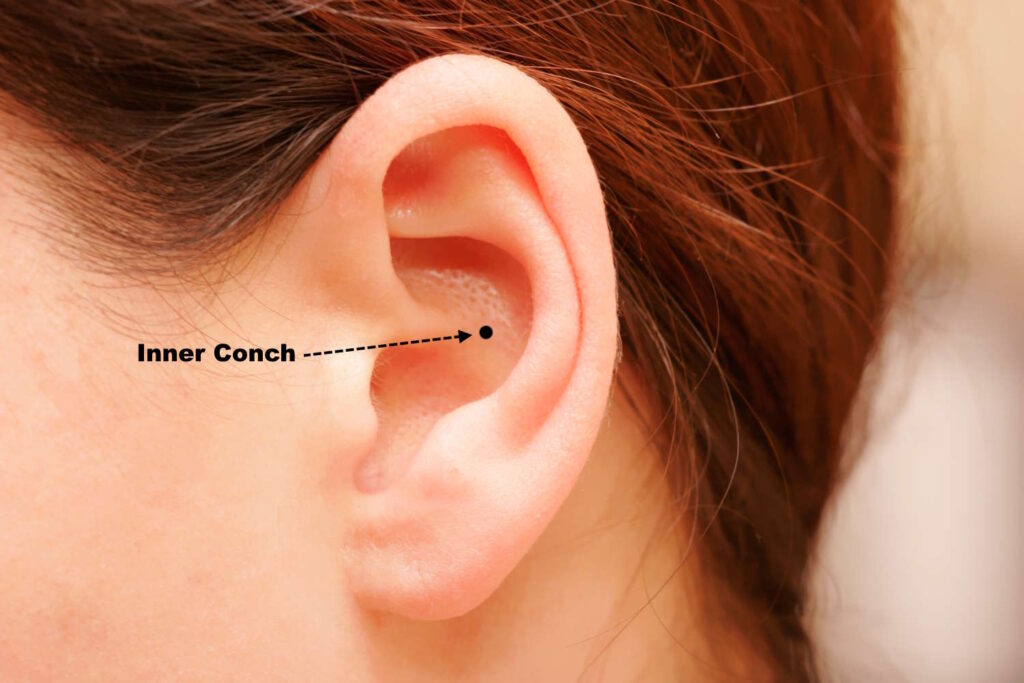
HISTORY OF THE CONCH
Did you know that this piercing has been more than just a trendy fad? In ancient times, the conch shell was so special that some folks believed it had spiritual powers. They even used it in religious ceremonies because it looked like a snail had a wild night out.
All kidding aside, across the world, different societies saw the conch piercing as a way of leveling up their status or as a rite of passage. Today, though, we just do it for the bling. And, with plenty of styles and jewelry options, you can mix and match to make your look pop! So go ahead and show off your unique style with a fancy inner conch piercing.

MYTH & MISCONCEPTIONS
Inner conch piercing is definitely not as scary as it seems. Here’s the lowdown on all the rumors:
- It Is A Painful Piercing: For most of us, the pain level is bearable. Some even claim an inner conch piercing is less painful than other piercings! So, don’t be scared, just go for it!
- It Is Difficult To Heal: Who says? With the right TLC, healing an inner conch piercing is a piece of cake. Of course, it might take you 6-9 months, but isn’t it true for everything good in life?
- It Will Affect Your Hearing: Since the piercing is on your outer ear, it’s unlikely to affect your hearing. Unless you pierce through your eardrum – but please don’t!
- It Is Only For Women: No way, Jose! Inner conch piercings are for anyone who wants to add some bling to their ear. So, if you’re a dude, a grandma, or a unicorn, feel free to rock it!
YOUNGER WOMEN AND MEN TAKE THE PRIZE
And now, the moment you’ve been waiting for – who wears inner conch piercing the most?
Sorry, grandpas and grandmas, but inner conch piercings tend to be more popular among the younger crowd. However, age is just a number, and everyone can get in on the fun. Just wait until you’re at least 18 and have your parent’s approval. Or better yet, wait until you’re 80 and don’t give a darn about anyone’s approval.
EAR-RITATION: RISKS OF THE INNER CONCH PIERCING
Say, you got yourself an inner conch piercing, huh? Fun times! But wait, what’s that? Complications, you say? Oh yeah, there are a few. But don’t worry – we won’t scare you so much that you’ll want to crawl back into your shell. Here are some potential complications:
- Infection: Getting an infection is one of the most common complications that can happen after any piercing. Signs of infection include redness, pain, discharge, fever, and swelling.
- Keloids: A keloid is a type of raised scar that can form at the site of the piercing. Keloids are often hereditary and can be difficult to treat.
- Rejection: It’s not you, it’s them! Your body, that is. Sometimes it mistakes your piercing for a foreign object and tries to get rid of it. Rude, right?
- Migration: Migration is when the piercing moves from its original placement. This can cause discomfort and damage to the surrounding tissue.
- Allergic Reactions: Just when you thought allergies were only triggered by pollen. If your piercing causes itching, redness, and swelling, you might have to ditch that jewelry for something less allergy-inducing.
RISKS OF THE INNER CONCH PIERCING
Certain underlying medical conditions such as diabetes or blood clotting disorders may increase the risk of complications, such as infections or excessive bleeding. It is essential to consult with a healthcare provider before getting a piercing.
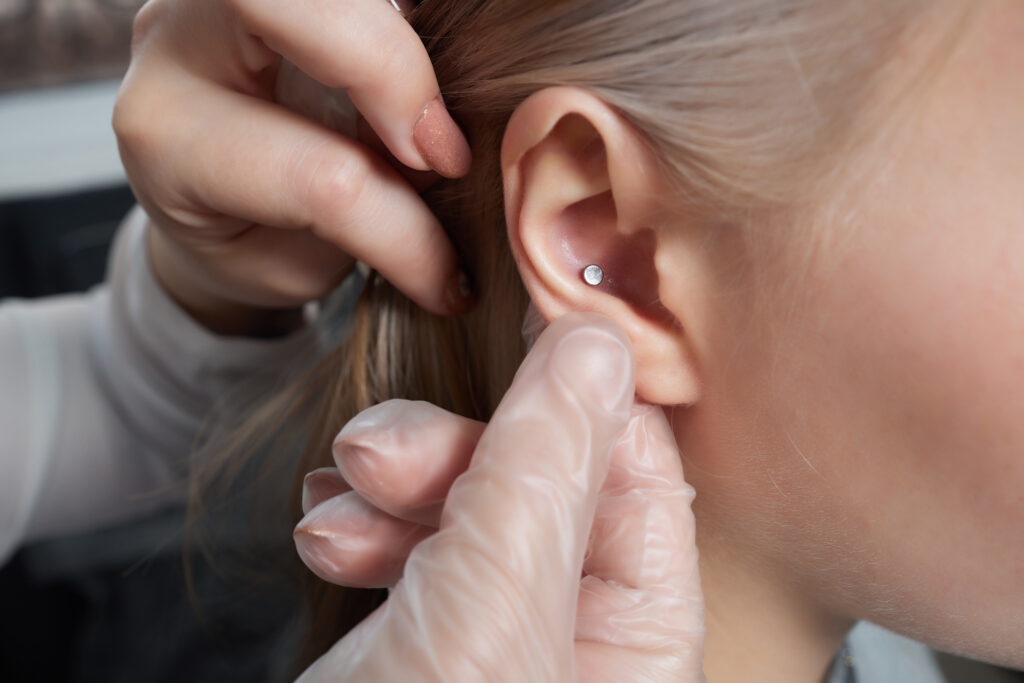
TRAPPED WITH THE INNER CONCH?
Depending on how long you’ve had the piercing and how well it has healed, the hole may take a while to shut up shop. But don’t be surprised if you’re still left with a slight scar or if the hole never closes up fully. Just think of it as a tiny reminder of your “wild” phase.
SELF-EXPRESSION HURTS SO GOOD: PAIN MANAGEMENT
The pain experienced during an inner conch piercing varies from person to person. Some people report feeling only a slight pinch or pressure, while others may experience more significant discomfort during the piercing process. However, the pain associated with an inner conch piercing is generally considered to be tolerable and short-lived. But fear not, my friend – you can survive the whole ordeal with these pain-management techniques:
- Deep Breathing And Relaxation: It’s time to put on your yoga pants and channel your inner Zen. Deep breathing and relaxation techniques can help you reduce anxiety and make the piercing process a little more comfortable. So take a deep breath, count to ten, and imagine you’re on a beach somewhere.
- Numbing Cream: Some people use a topical numbing cream to help reduce pain during the piercing. It’s important to note that numbing cream may not work for everyone and may have some side effects.
- Over-The-Counter Pain Relievers: Taking an over-the-counter pain reliever such as ibuprofen or acetaminophen can help reduce pain and discomfort after the piercing. It’s important to follow the dosage instructions carefully and consult with a healthcare provider if you have any concerns.
- Ice Packs: Ice, ice, baby! Applying a cold compress to the piercing site can help you reduce inflammation and discomfort. It’s like a mini-vacation for your ear. Just don’t use a popsicle – that’s just gross.
SHELLING OUT THE DOUGH
Money, money, money – it makes the world go round, and now it’s time to talk about the cost of an inner conch piercing. But don’t be a penny-pincher – you want to make sure you’re getting a safe and professional piercing, right? Here’s what you can expect to pay in different parts of the country:
- East Coast: $50-$100
Major Cities: New York City, Washington D.C., Boston, Philadelphia, Miami - West Coast: $60-$120
Major Cities: Los Angeles, San Francisco, Seattle, Portland - Midwest: $40-$90
Major Cities: Chicago, Detroit, Minneapolis, St. Louis, Kansas City - South: $30-$80
Major Cities: Houston, Atlanta, Nashville, New Orleans, Dallas
But don’t be fooled – these are just estimated costs. Depending on the piercer and the location, you might need to adjust your budget. And keep in mind the type of jewelry, the complexity of the piercing, and the aftercare products. After all, you don’t want to buy a cheap piercing and end up with a crooked earring in your conch. Choose a reputable piercer who follows safety and hygiene protocols – you don’t want to risk any complications.
INNER CONCH PIERCING PROCEDURE
Before we get to the procedure, let’s talk about the needle! The inner conch piercing gauge is usually 14 or 16, depending on the piercer’s preference and the jewelry you choose. The gauge refers to the thickness of the needle, and the lower the gauge number, the thicker the needle. But don’t worry – even though it might sound like a punch to the ear, it’s not that bad.
Here is a general overview of the inner conch piercing procedure:
- Consultation: Your piercer will ask you where you want the piercing and answer any questions or concerns you have. They’ll also scope out your ear to figure out the best place to stick the needle. Fun times!
- Preparation: Cleanliness is next to godliness, so the piercer will sterilize the area and mark the spot with a special skin marker. You know, like a temporary tattoo, only cooler.
- Piercing: Here it comes – the moment you’ve been waiting for! The piercer will use a sterilized needle to pierce the conch area of your ear. No worries – the pain lasts like a second or two.
- Aftercare: The piercer will provide aftercare instructions, which may include cleaning the area with saline solution or another recommended solution several times a day and avoiding certain activities that might irritate the piercing.
The entire procedure should take no more than a few minutes. It’s important to choose a reputable piercer who follows safety protocols to minimize the risk of complications discussed above.
PAIN MEET PATIENCE
Now, be patient, because Rome wasn’t built in a day, and neither is your healing. Here’s what you need to know.
The healing time varies from person to person, but typically it can take six to nine months to heal completely. It may be a little tender, a little swollen, and a little discharge-y during the first few days or weeks after the piercing, but that’s just your body’s way of saying “thanks for the puncture wound.”
After the initial healing period, the skin around the piercing may begin to form a protective layer of tissue that will help prevent bacteria from entering the wound. This new skin bridge is called the fistula. It’s important to avoid touching or turning the jewelry during this time as it may aggravate or slow down the healing process.
Note that even after the initial healing period is over, the piercing may still be sensitive and require extra care for several months. It’s recommended to continue regular aftercare procedures.
FROM ICE ICE BABY TO SEA SALT SAVVY
Proper aftercare is important for ensuring the healing of an inner conch piercing and reducing the risk of complications. Here are some general aftercare procedures for an inner conch piercing:
- Clean The Piercing: Grab some saline solution or a recommended cleaning product and use it twice a day. Soak a cotton swab or ball in the solution and gently remove any crust or debris that may have formed around the piercing.
- Avoid Touching The Piercing: No touchie! Avoid touching the piercing with unwashed hands or letting anyone else get their grubby paws on it. Touching can introduce bacteria and mess with the healing process.
- Be Careful With Clothing And Hair: Avoid wearing hats that may press against the piercing, and try to keep long hair or other objects away from the area to avoid pulling or irritating the piercing.
- Avoid Submerging The Piercing: Time to say goodbye to swimming pools, hot tubs, or any other body of water until the piercing is fully healed. If you absolutely must take a dip, be sure to clean it thoroughly afterward.
- Avoid Alcohol Or Other Acidic Products: Step away from the alcohol and peroxide! Using any acidic product can cause dryness, irritation, and even tissue damage. Stick with saline solution or other professionally recommended products to promote healing.
Remember, the healing process may vary from person to person, so it’s important to follow the aftercare instructions provided by a professional piercer, keep up with cleaning, avoid irritants, and be aware of any signs of infection.
THE LONG-AWAITED CHANGE
Oh snap, inner conch piercings are all the rage! But hold your horses, buckaroo. You gotta give that piercing some time to heal before you change the jewelry. It’s a waiting game, y’all. Generally, it’ll take about 6 to 9 months for the piercing to heal, but some folks might need even more time.
Believe it or not, changing the jewelry too soon can mess with the healing tissue and prolong the recovery process. Nobody wants that, right? So, be patient and let nature do its thing.
But, if you absolutely gotta switch things up, make sure you do it under the watchful eye of a professional piercer. They’ll use specialized and sanitized tools to remove and insert the jewelry safely, without causing any damage to that sensitive healing tissue.
WHAT JEWELRY MATERIAL SHOULD I GET
Are you ready to jazz up that inner conch piercing with some new bling? Be aware that you gotta pick the right kind of jewelry. You want to avoid any irritation to that sensitive tissue, cause nobody wants an angry ear!
So, what’s the deal with materials? You’ll want to choose high-quality, hypoallergenic materials for your new jewelry. Here are some top picks:
- Implant-Grade Titanium: Titanium is one of the best materials for piercings because it’s lightweight, strong, and hypoallergenic.
- Niobium: This is another metal that’s hypoallergenic and comes in different colors like dark blue or brown.
- Gold: Pure gold (not alloyed or mixed with other metals) can be a great choice for those with sensitive skin. Make sure the gold is at least 18 karat, as lower karat gold may contain other metals that can cause an allergic reaction.
- Surgical Steel: High-quality surgical steel is also an option, but don’t worry, it won’t turn you into a cyborg. Not yet, anyway.
It’s important to avoid jewelry made from nickel, copper, brass, or other materials that can cause an allergic reaction. You should also avoid jewelry with coatings or plating that can wear off and expose skin to metals.
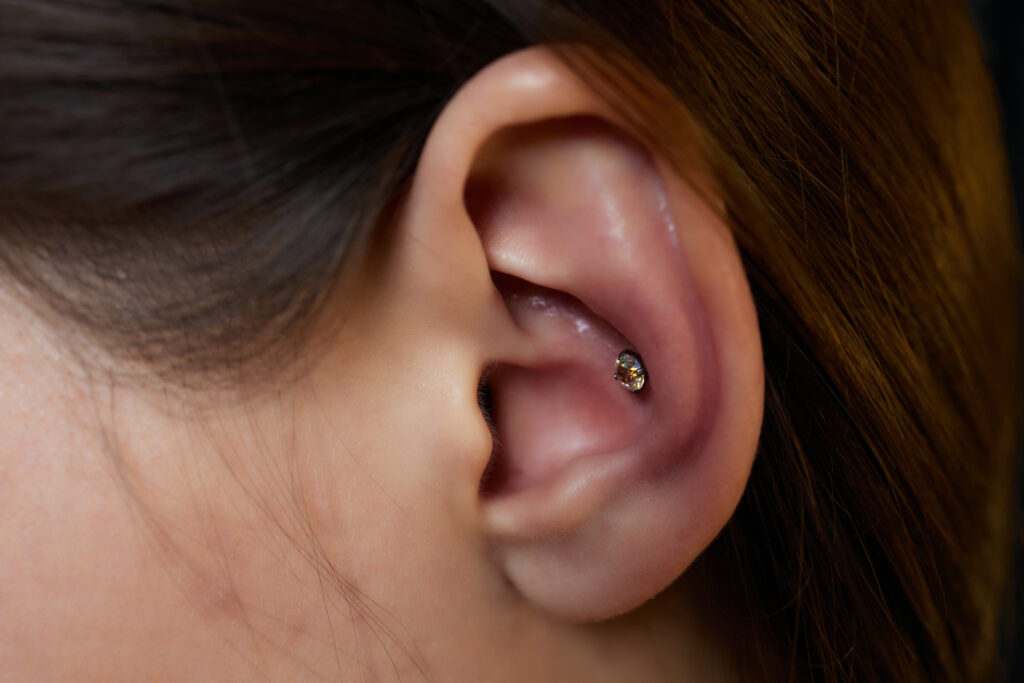
INNER CONCH JEWELRY DESIGNS
There are two main styles of jewelry that are ideal for an inner conch piercing, and the style that is best for you will depend on your personal preferences and anatomy. Here are some common styles of jewelry for an inner conch:
- Labrets: These are the most common type of jewelry for an inner conch piercing. They have a straight post with a decorative front and a screw-on or lock backing.
- Studs: These types of jewelry have a flat backing that sits tightly against the back of the ear.
WHEN CELEBRITIES LEAD, WE FOLLOW
You wanna be hip and trendy with a new inner conch piercing? Well, let me tell you, you’re in good company! Celebrities have been hopping on the piercing train, too! Here are just a few famous faces who’ve embraced the inner conch trend:
- Emma Stone: You know the gal who won an Oscar for La La Land? She’s got a single inner conch piercing in her left ear. And we gotta say, she looks jazzy as heck!
- Rihanna: This lady is a fashion icon and a music mogul. She’s also got an inner conch piercing on her right ear. Move over, diamond earrings!
- Zoë Kravitz: This actress and musician rocks not one, but two inner conch piercings on her right ear.
- Kendall Jenner: The model and reality TV star has been spotted with an inner conch piercing on her right ear. Maybe she learned some piercing tips from her supermodel sisters
- Scarlett Johansson: The actress and director has an inner conch piercing on her left ear.
- Miley Cyrus: The musician and actress has multiple ear piercings, including an inner conch piercing on her right ear. Nothing can stop Miley from being a piercing queen!
- Lena Dunham: The actress and writer has a single inner conch piercing on her right ear.
But hey, don’t just rely on ‘celeb-spiration’ on your piercing journey. Remember, everyone’s body reacts differently to piercings. So make sure to seek proper advice from a professional before you take the piercing plunge.
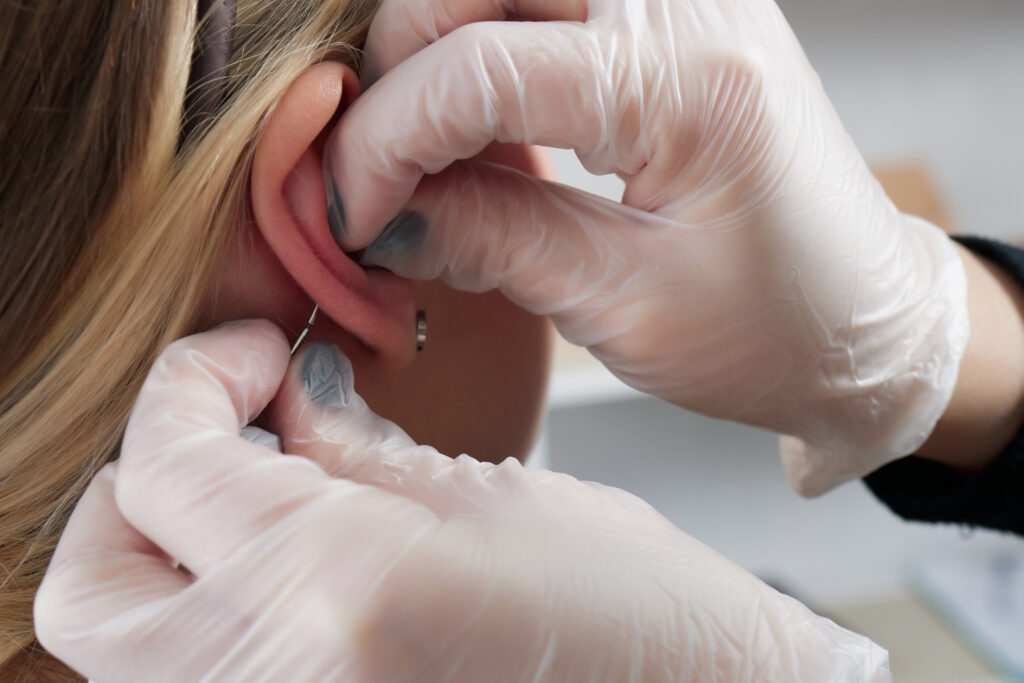
DECISION TIME: YES OR NO TO THE INNER CONCH?
While the inner conch piercing may not have a plethora of cultural or religious meaning, it has gained popularity as a form of self-expression and a fashion statement. The procedure for piercing is relatively straightforward and can cause minimal pain. The healing time and aftercare routine must be followed carefully to minimize the risks of complications. Using high-quality inner conch jewelry and avoiding activities that could irritate the piercing can help ensure a successful healing process. As more celebrities and people embrace this piercing, it’s essential to understand the potential risks and recommend aftercare practices to enjoy the piercing’s beauty safely.
Need to find a piercer? Check out the Association of Professional Piercers.
Author: Scott S.
